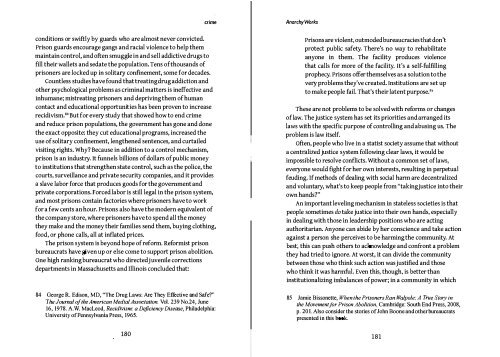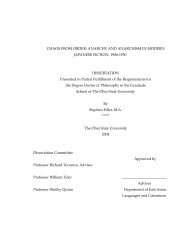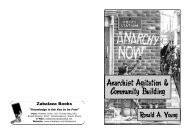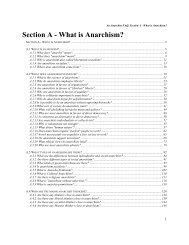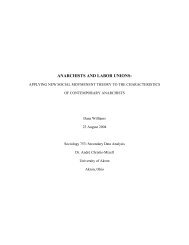Anarchy Works.pdf - Infoshop.org
Anarchy Works.pdf - Infoshop.org
Anarchy Works.pdf - Infoshop.org
You also want an ePaper? Increase the reach of your titles
YUMPU automatically turns print PDFs into web optimized ePapers that Google loves.
crime<br />
<strong>Anarchy</strong> <strong>Works</strong><br />
conditions or swiftly by guards who are almost never convicted.<br />
Prison guards encourage gangs and racial violence to help them<br />
maintain control, and often smuggle in and sell addictive drugs to<br />
fill their wallets and sedate the population. Tens of thousands of<br />
prisoners are locked up in solitary confinement, some for decades.<br />
Countless studies have found that treating drug addiction and<br />
other psychological problems as criminal matters is ineffective and<br />
inhumane; mistreating prisoners and depriving them of human<br />
contact and educational opportunities has been proven to increase<br />
recidivism." But for every study that showed how to end crime<br />
and reduce prison populations, the government has gone and done<br />
the exact opposite: they cut educational programs, increased the<br />
use of solitary confinement, lengthened sentences, and curtailed<br />
visiting rights. Why? Because in addition to a control mechanism,<br />
prison is an industry. It funnels billions of dollars of public money<br />
to institutions that strengthen state control, such as the police, the<br />
courts, surveillance and private security companies, and it provides<br />
a slave labor force that produces goods for the government and<br />
private corporations. Forced labor is still legal in the prison system,<br />
and most prisons contain factories where prisoners have to work<br />
for a few cents an hour. Prisons also have the modern equivalent of<br />
the company store, where prisoners have to spend all the money<br />
they make and the money their families send them, buying clothing,<br />
food, or phone calls, all at inflated prices.<br />
The prison system is beyond hope of reform. Reformist prison<br />
bureaucrats have given up or else come to support prison abolition.<br />
One high ranking bureaucrat who directed juvenile corrections<br />
departments in Massachusetts and Illinois concluded that:<br />
84<br />
Ge<strong>org</strong>e R. Edison, MD, "The Drug Laws: Are They Effective and Safe?"<br />
The Journal of the American Medial Association, Vol. 239 No.24, June<br />
16, 1978. A W. MacLeod, Recidivism: a Deficiency Disease, Philadelphia:<br />
University of Pennsylvania Press, 1965.<br />
Prisons are violent, outmoded bureaucracies that don't<br />
protect public safety. There's no way to rehabilitate<br />
anyone in them. The facility produces violence<br />
that calls for more of the facility. It's a self-fulfilling<br />
prophecy. Prisons offer themselves as a solution to the<br />
very problems they've created. Institutions are set up<br />
to make people fail. That's their latent purpose.a,<br />
These are not problems to be solved with reforms or changes<br />
oflaw. The justice system has set its priorities and arranged its<br />
laws with the specific purpose of controlling and abusing us. The<br />
problem is law itself.<br />
Often, people who live in a statist society assume that without<br />
a centralized justice system following dear laws, it would be<br />
impossible to resolve conflicts. Without a common set of laws,<br />
everyone would fight for her own interests, resulting in perpetual<br />
feuding. If methods of dealing with social harm are decentralized<br />
and voluntary, what's to keep people from "taking justice into their<br />
own hands?"<br />
An important leveling mechanism in stateless societies is that<br />
people sometimes do take justice into their own hands, especially<br />
in dealing with those in leadership positions who are acting<br />
authoritarian. Anyone can abide by her conscience and take action<br />
against a person she perceives to be harming the community. At<br />
best; this can push others to acknowledge and confront a problem<br />
they had tried to ignore. At worst, it can divide the community<br />
between those who think such action was justified and those<br />
who think it was harmfuL Even this, though, is better than<br />
institutionalizing imbalances of power; in a community in which<br />
85 Jamie Bissonette, When the Prisoners Ran Walpole: A Trite Story in<br />
the Movementfor Prison Abolition, Cambridge: South End Press, 2008,<br />
p. 20 I, Also consider the stories of John Boone and other bureaucrats<br />
presented in this bnnk,<br />
180<br />
181


